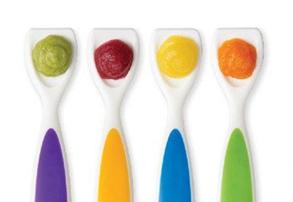Here is what I wish I knew before introducing solid foods to my twins. When serving your baby solid foods you just need a few things:
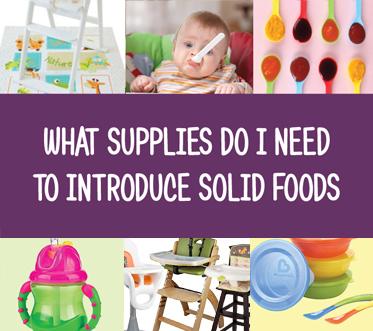
- Bibs
- Spoons
- Sippy Cup
- Small bowl
- Mat under high chair for easy clean up
- High chair
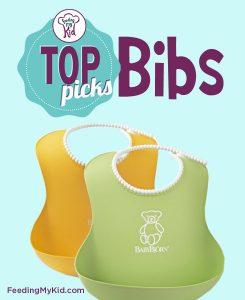 Bibs
Bibs
There are number of bibs to choose from. There are cloth or plastic fabric bibs to pelican bibs to catch the food in as if falls. Over time, I found the pelican bibs to be the best option since it really helped catch more food before it fell on their laps and floor. Less clean up for me 😉
Check out our recommendations for bibs.
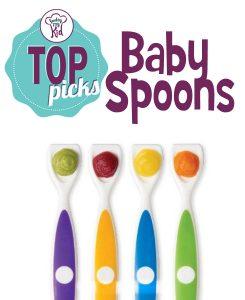 Spoons
Spoons
We actually used three different kinds of spoons. It’s easier for young babies to take the food off the spoon if it is flat. And then as they become better at removing food from the spoon you can introduce a regular baby spoon. Finally, as they start to move on to feeding themselves, we used the spoons that are curved and shorter so it’s easier for them to angle them into their mouths.
Here is a list of our favorite spoons.
Between 7-9 months, the infant learns to cup the tongue for the spoon, and close their lips around the spoon to help draw the food into the mouth (Glass and Wolf, 1992).
Tip: Make sure you are not scraping the food off in their mouth, but instead, allowing your baby to put their lips around the spoon and take the food off by himself.
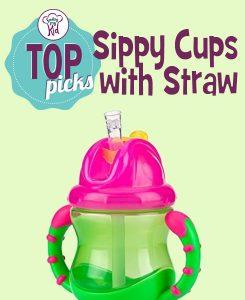 Sippy Cup with Straws
Sippy Cup with Straws
Introducing a sippy cup or regular cup to your child helps with hand-eye coordination and strengthens his muscles in their lips, cheeks and mouth. The stronger these muscles get the more successful your little one will be at eating.
See our list of our favorite sippy cups and traditional cups.
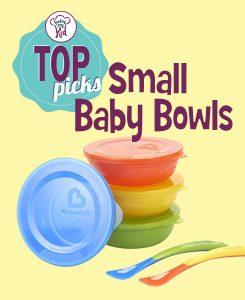 Small Bowls
Small Bowls
Take a small amount of the food you prepared or jarred food and put it in a bowl to feed your baby. Your baby will only be eating about a tablespoon or two of food at first. No need to waste the entire pouch of food. Saliva contaminates food and can build a dangerous amount of bacteria, so it’s important to separate the food into about a serving size, so you don’t risk contaminating it.
For a list of some suggestions, see our list of favorite bowls.
 High Chairs
High Chairs
Initially, we bought high chairs that attach to our regular chairs so we don’t overcrowd our eat-in area. I kept noticing that my daughter was slouching in the high chair. I went to a class on picky eating and the Occupational Therapist highly recommend we find new chairs that put our child at a 90-degree angle from back to where their knees bend.
We have curated a list of our top high chairs and trays for you to check out.
It’s best if your child can sit with you at the table. Mealtime is a social time and it’s good to start this habit early.
Children will often eat more and a larger variety of foods when they are seeing his parents modeling the behavior. So sit with your children at the table and enjoy a nice meal with them.
Find Out the Importance of Posture and Eating
Floor Mats
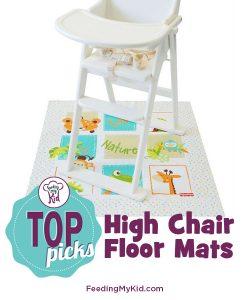 Early on, the whole process of introducing solids can be so messy! It’s a part of the learning process for babies. Find out why.
Early on, the whole process of introducing solids can be so messy! It’s a part of the learning process for babies. Find out why.
Purchasing a mat will definitely help with the mess. The food will be easier to wipe off.
Here are some of our favorite mats under high chair for easy clean up.
Don’t Forget About Hygiene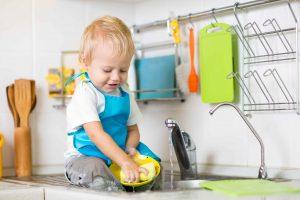
Wash your babies hands before eating. Clean the highchair and supplies after each meal. For babies under six months, sterilize feeding supplies. For babies over six months, wash supplies thoroughly or send them through the dishwasher. Make sure the products your purchase are dishwasher safe if you go down this route.
Additional Information:
Will you be making your own purees, using pre-made foods or trying baby-led weaning?
Whichever option you choose, make sure you speak with your Pediatrician and are aware of any potential food allergy issues.
Here is everything I wish someone told me. Making your own baby food?
Find out how to best cook the baby food before pureeing it to keep the most nutrients.
Also, check out this example baby feeding schedule and baby feeding milestone tracker. Ultimately, every baby is different. Go at your baby’s pace and have fun!
There are many different techniques on how to prepare and store baby food. Play around and see works for you.
Once you start introducing solids, you may notice your child seems to be barely eating, gagging, or making funny faces. These are all normal!
Subscribe to Feeding My Kid’s Youtube Channel for our video series about how to best feed your baby, toddler, and school-aged child.
Share your comments below.


